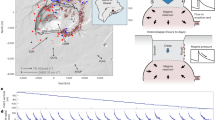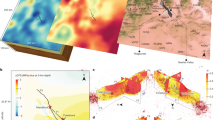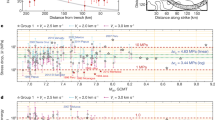Abstract
It is well established that an earthquake in the Earth's crust can trigger subsequent earthquakes, but such triggering has not been documented for deeper earthquakes. Models for shallow fault interactions suggest that static (permanent) stress changes can trigger nearby earthquakes, within a few fault lengths from the causative earthquake1,2,3, whereas dynamic (transient) stresses carried by seismic waves may trigger earthquakes both nearby and at remote distances4,5,6,7,8. Here we present a detailed analysis of the 19 August 2002 Tonga deep earthquake sequences and show evidence for both static and dynamic triggering. Seven minutes after a magnitude 7.6 earthquake occurred at a depth of 598 km, a magnitude 7.7 earthquake (664 km depth) occurred 300 km away, in a previously aseismic region. We found that nearby aftershocks of the first mainshock are preferentially located in regions where static stresses are predicted to have been enhanced by the mainshock. But the second mainshock and other triggered events are located at larger distances where static stress increases should be negligible, thus suggesting dynamic triggering. The origin times of the triggered events do not correspond to arrival times of the main seismic waves from the mainshocks and the dynamically triggered earthquakes frequently occur in aseismic regions below or adjacent to the seismic zone. We propose that these events are triggered by transient effects in regions near criticality, but where earthquakes have difficulty nucleating without external influences.
This is a preview of subscription content, access via your institution
Access options
Subscribe to this journal
Receive 51 print issues and online access
$199.00 per year
only $3.90 per issue
Buy this article
- Purchase on Springer Link
- Instant access to full article PDF
Prices may be subject to local taxes which are calculated during checkout




Similar content being viewed by others
References
King, G. C. P., Stein, R. S. & Lin, J. Static stress changes and the triggering of earthquakes. Bull. Seismol. Soc. Am. 84, 935–953 (1994)
Harris, R. A. Introduction to special section: stress triggers, stress shadows, and implications for seismic hazard. J. Geophys. Res. 103, 24347–24358 (1998)
Stein, R. S. The role of stress transfer in earthquake occurrence. Nature 402, 605–609 (1999)
Hill, D. P. et al. Seismicity remotely triggered by the magnitude 7.3 Landers, California, earthquake. Science 260, 1617–1623 (1993)
Harris, R. A. & Day, S. M. Dynamics of faults interaction: parallel strike-slip faults. J. Geophys. Res. 98, 4461–4472 (1993)
Belardinelli, M. E., Cocco, M., Coutant, O. & Cotton, F. Redistribution of dynamic stress during coseismic ruptures: evidence for fault interaction and earthquake triggering. J. Geophys. Res. 104, 14925–14945 (1999)
Kilb, D., Gomberg, J. & Bodin, P. Triggering of earthquake aftershocks by dynamic stresses. Nature 408, 570–574 (2000)
Gomberg, J., Blanpied, M. L. & Beeler, N. M. Transient triggering of near and distant earthquakes. Bull. Seismol. Soc. Am. 87, 295–309 (1997)
Frohlich, C. The nature of deep-focus earthquakes. Annu. Rev. Earth Planet. Sci. 17, 227–254 (1989)
Green, H. W. & Houston, H. The mechanics of deep earthquakes. Annu. Rev. Earth Planet. Sci. 23, 169–213 (1995)
Kirby, S. H., Stein, S., Okal, E. A. & Rubie, D. C. Metastable mantle phase transformations and deep earthquake in subducting oceanic lithosphere. Rev. Geophys. 34, 261–306 (1996)
Wiens, D. A. Seismological constraints on the mechanism of deep earthquakes: temperature dependence of deep earthquake source properties. Phys. Earth. Planet. Inter. 127, 145–163 (2001)
Tibi, R., Bock, G. & Wiens, D. A. Source characteristics of large deep earthquakes: constraint on the faulting mechanism at great depths. J. Geophys. Res. 108, doi:101029/2002JB001948 (2003)
Jaeger, J.C. & Cook, N.G.W. Fundamentals of Rock Mechanics (Chapman and Hall, London, 1979)
Wiens, D. W. & McGuire, J. J. Aftershocks of the March 9, 1994, Tonga earthquake: the strongest known deep aftershock sequence. J. Geophys. Res. 105, 19067–19083 (2000)
Cotton, F. & Coutant, O. Dynamic stress variations due to shear faults in a plane-layered medium. Geophys. J. Int. 128, 676–688 1997)
Kisslinger, C. A review of theories of mechanisms of induced seismicity. Eng. Geol. 10, 85–98 (1976)
Gomberg, J., Reasenberg, P. A., Bodin, P. & Harris, R. A. Earthquake triggering by seismic waves following the Landers and Hector Mine earthquakes. Nature 411, 462–466 (2001)
Van der Hilst, R. D. Complex morphology of subducted lithosphere in the mantle beneath the Tonga trench. Nature 374, 154–157 (1995)
Chen, W.-P. & Brudzinski, M. R. Evidence for a large-scale remnant of subducted lithosphere beneath Fiji. Science 292, 2475–2479 (2001)
Tibi, R. Untersuchungen der Ursache von Tiefherdbeben mit Hilfe von Breitbandseismogrammen. Scientific Technical Report STR00/08 (GeoForschungsZentrum Potsdam, Potsdam, 2000)
McGuire, J. J., Wiens, D. A., Shore, P. J. & Bevis, M. G. The March 9, 1994 (Mw 7.6), deep Tonga earthquake: rupture outside the seismically active slab. J. Geophys. Res. 102, 15163–15182 (1997)
Hudnut, K. W., Seeber, L. & Pacheco, J. Cross-fault triggering in the November 1987 Superstition Hills earthquake sequence, Southern California. Geophys. Res. Lett. 16, 199–202 (1989)
Freed, A. M. & Lin, J. Delayed triggering of the 1999 Hector Mine earthquake by viscoelastic stress transfer. Nature 411, 180–183 (2001)
Pollitz, F. F. & Sacks, I. S. The 1995 Kobe, Japan, earthquake: a long-delayed aftershock of the offshore 1944 Tonankai and 1946 Nankaido earthquakes. Bull. Seismol. Soc. Am. 87, 1–7 (1997)
King, G. C. P. & Cocco, M. Fault interaction by elastic stress changes: new clues from earthquake sequences. Adv. Geophys. 44, 1–38 (2000)
Ogawa, M. Shear instability in a viscoelastic material as the cause of deep focus earthquakes. J. Geophys. Res. 92, 13801–13810 (1987)
Hobbs, B. E. & Ord, A. Plastic instabilities: implications for the origin of intermediate and deep focus earthquakes. J. Geophys. Res. 93, 10521–10521 (1988)
Karato, S., Riedel, M. R. & Yuen, D. A. Rheological structure and deformation of subducted slabs in the mantle transition zone: implications for mantle circulation and deep earthquakes. Phys. Earth Plant. Inter. 127, 83–108 (2001)
Jordan, T. H. & Sverdrup, K. A. Teleseismic location techniques and their application to earthquake clusters in the South-Central Pacific. Bull. Seismol. Soc. Am. 71, 1105–1130 (1981)
Nábělek, J. L., Determination of Earthquake Source Parameters from Inversion of Body Waves. PhD thesis, MIT (1984)
Toda, S., Stein, R. S., Reasenberg, P. A., Dieterich, J. H. & Yoshida, A. Stress transferred by the 1995 Mw = 6.9 Kobe, Japan, shock: effect on aftershocks and future earthquake probabilities. J. Geophys. Res. 103, 24543–24565 (1998)
Engdahl, E. R., van der Hilst, R. & Buland, R. Global teleseismic earthquake relocation with improved travel times and procedures for depth determination. Bull. Seismol. Soc. Am. 88, 722–742 (1998)
Gudmundsson, Ó. & Sambridge, M. A regionalized upper mantle (RUM) seismic model. J. Geophys. Res. 103, 7121–7136 (1998)
Dziewonski, A. M., Chou, T.-A. & Woodhouse, J. H. Determination of earthquake source parameters from waveform data for studies of global and regional seismicity. J. Geophys. Res. 86, 2825–2852 (1981)
Acknowledgements
We thank D. Suetsugu and the operators of the SPANET network for their efforts, R. Stein for making his code available, and J. Conder and N. Kagotho for reading the manuscript. Waveforms data were supplied by the Incorporated Research Institutions for Seismology (IRIS), Geoscope, and GeoForschungsNetz (GEOFON). Arrival time data were obtained from the ISC and PDE (US Geological Survey). This research was supported by the National Science Foundation.
Author information
Authors and Affiliations
Corresponding author
Ethics declarations
Competing interests
The authors declare that they have no competing financial interests.
Rights and permissions
About this article
Cite this article
Tibi, R., Wiens, D. & Inoue, H. Remote triggering of deep earthquakes in the 2002 Tonga sequences. Nature 424, 921–925 (2003). https://doi.org/10.1038/nature01903
Received:
Accepted:
Issue Date:
DOI: https://doi.org/10.1038/nature01903
This article is cited by
-
Spatio-temporal clustering of successive earthquakes as inferred from analyses of global CMT and NIED F-net catalogs
Earth, Planets and Space (2022)
-
Slow deformation event between large intraslab earthquakes at the Tonga Trench
Scientific Reports (2021)
-
Rupture processes and Coulomb stress changes of the 2017 Mw 6.5 Jiuzhaigou and 2013 Mw 6.6 Lushan earthquakes
Earth, Planets and Space (2019)
-
Limitations of rupture forecasting exposed by instantaneously triggered earthquake doublet
Nature Geoscience (2016)
-
Complete Coulomb stress changes induced by the Ms7.6 earthquake in Lancang-Gengma, Yunnan and triggering of aftershocks by dynamic and static stress
Science in China Series D: Earth Sciences (2007)
Comments
By submitting a comment you agree to abide by our Terms and Community Guidelines. If you find something abusive or that does not comply with our terms or guidelines please flag it as inappropriate.



